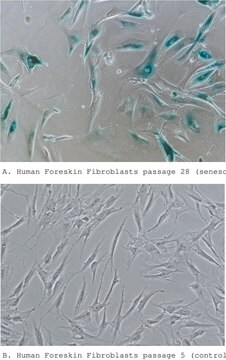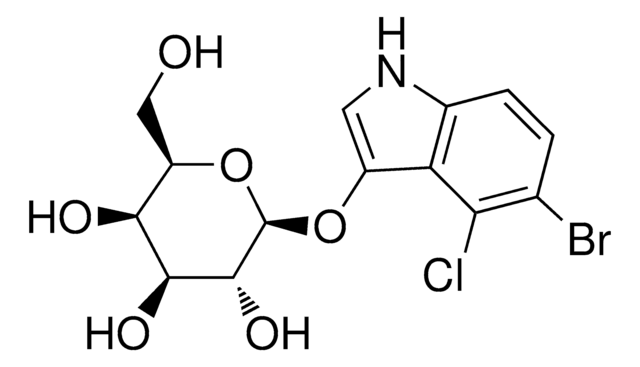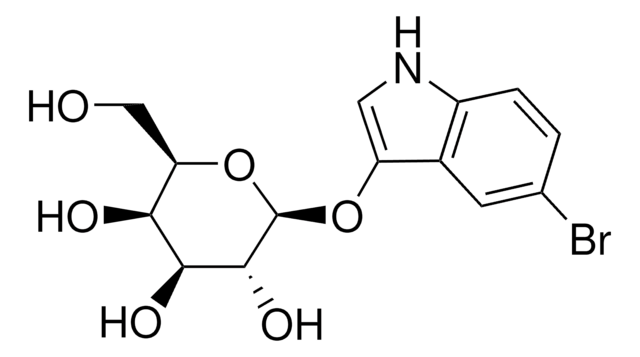Key Documents
94433
β-Galactosidase stain
Synonim(y):
6′-(Diethylamino)-4′-(fluoromethyl)spiro[isobenzofuran-1(3H),9′-[9H]xanthen]-3′-yl β-D-galactopyranoside, SPiDER-βGal, SPiDER-beta Gal, (2S,3R,4S,5R,6R)-2-{[3’-(Diethylamino)-5’-(fluoromethyl)-3H-spiro(isobenzofuran-1,9’-xanthen)-6’-yl]oxy}-6-(hydroxymethyl)tetrahydro-2H-pyran-3,4,5-triol
About This Item
Polecane produkty
Postać
solid
Poziom jakości
temp. przechowywania
2-8°C
ciąg SMILES
O[C@@H]1[C@@H](O)[C@H](OC(C=C2)=C(CF)C3=C2C4(C(C=CC=C5)=C5CO4)C(C=CC(N(CC)CC)=C6)=C6O3)O[C@H](CO)[C@@H]1O
Opis ogólny
To overcome these issues, Urano, Kamiya and co-workers have successfully developed a stain ideally possesses cell-permeability and the ability to retain in intracellular region.1)
By the enzymatic reaction, the β-Galactosidase stain immediately forms a quinone methide that acts as electrophile when proteins containing nucleophilic functional groups nearby the molecules. By the probe undergoes the reaction with a protein, the conjugates become fluorescent compounds. Thus, it allows a single-cell analysis because it does self-immobilizing to the intracellular proteins.
Exciation Maximum: 530 nm (± 10 nm)
Emission Maximum: 550 nm (± 10 nm)
Reference:
1) Y. Urano, M. Kamiya, T. Doura, WO 2015174460, A1, (19, November, 2015).
Find more infomation here 94433
Zastosowanie
Add 35 μl of DMSO to a tube of stain solution (20 μg) and dissolve it with pipetting.
*Store the stock solution at -20°C.
Preparation of 1 μmol/l stain working solution
Dilute the stain DMSO stock solution with Hanks′ HEPES buffer to prepare 1 μmol/l stain working solution.
*Hanks′ HEPES buffer is recommended to maintain cell condition.
General protocol:
staining
1. Prepare cells for the assay.
2. Discard the culture medium and wash the cells with Hanks′ HEPES buffer twice.
3. Add an appropriate volume of stain working solution.
4. Incubate at 37oC for 15 minutes.
5. Observe the cells under a fluorescence microscope or by a flow cytometer.
*After staining, the cells can be observed even without washing. However, you can wash it as needed.
Kod klasy składowania
11 - Combustible Solids
Klasa zagrożenia wodnego (WGK)
WGK 3
Certyfikaty analizy (CoA)
Poszukaj Certyfikaty analizy (CoA), wpisując numer partii/serii produktów. Numery serii i partii można znaleźć na etykiecie produktu po słowach „seria” lub „partia”.
Masz już ten produkt?
Dokumenty związane z niedawno zakupionymi produktami zostały zamieszczone w Bibliotece dokumentów.
Klienci oglądali również te produkty
Nasz zespół naukowców ma doświadczenie we wszystkich obszarach badań, w tym w naukach przyrodniczych, materiałoznawstwie, syntezie chemicznej, chromatografii, analityce i wielu innych dziedzinach.
Skontaktuj się z zespołem ds. pomocy technicznej






